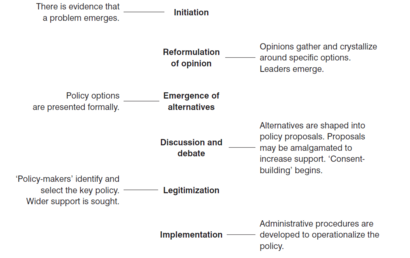QA4ODFL1/Policy/Policy formulation
Policy formulation does not take place in a vacuum, it is a process that is influenced by and responds to a particular context. Policy responses are shaped by cultural context ( Bell & Stevenson, 2006) [1], which determines the process through which policy is formulated. If policy is about solving problems, the policy process should therefore be rational. This process starts with identification of a problem around which a variety of solution options are sought. The search for the most viable solution results in some degree of consensus being reached on the best option and guidelines are developed around the preferred option. Figure 1 below shows Bell & Stevenson’s easy-to-understand graphic of this linear approach to policy development:
Fig. 1 A linear model of policy development
Source: Bell, L & Stevenson, H (2006:16)
| Process | Summary |
|---|---|
| Step 1: Identifying issues (which normally create a state of uneasiness in people) and define problems | Example can be having many school-going age children out of school. This may be due to limited capacity in existing schools, or the sparsely distributed nature of the population. The latter makes it less cost-effective to build schools for only a handful of learners in particular areas than to provide education through other means. |
| Step 2: Analysing issues and setting the agenda | Debates, concerns and complaints at political and community levels are held about the high number of out-of-school learners and the negative consequences this has on socio-economic development. These debates culminate in the matter becoming an issue, a problem that needs attention. |
| Step 3: Selecting from a range of options | Many options for solving the problem are discussed and analysed. For example, some people may suggest transporting learners to distant schools every day; others may suggest using distance education; yet others may suggest using makeshift classrooms where learners are taught by unqualified community-based mentors. Various factors around these different options are considered and one option is finally settled for. |
| Step 4: Drafting policy instruments | Policy guidelines are developed around the preferred option to guide implementation. The drafting is done by very few people deemed to have expertise, like relevant people in the Ministry of Education. In some contexts, input into the draft policy (White Paper) from various stakeholders is sought before official approval of the policy. |
| Step 5: Decision making and policy advocacy | To maximise buy-in, policy advocacy is undertaken to familiarise everyone in the context with the policy. Strategies for implementing the policy are also formulated. Resources are mobilised to make implementation feasible. |
| Step 6: Implementing new policy | Actions are undertaken to give practical effect to the policy text. This is the most critical stage in the policy process as implementation involves a wide range of implementers the majority of who are not part of the policy making process. Often, there are disparities between the spirit with which the policy is developed and the zeal with which it is implemented. This leads to glaring gaps between policy in text and policy in practice. That is why careful monitoring of policy implementation becomes so key. Although this is given as the next stage, monitoring and evaluation actually have to happen as policy implementation unfolds. Where policy implementation is done well, it is accompanied by research which feeds back into the process. |
| Step 7: Monitoring and evaluating policy | Although there is continuous (formative) evaluation during policy implementation, there is also terminal evaluation that takes place after a certain period of policy implementation – usually 3-5 years. At this stage, an external expert maybe invited to undertake the evaluation and provide feedback with recommendations. |
It is worth noting that although policy making has been presented as a linear process above, it is often an iterative and messy process. Usually, the policy making process is a cyclical process. Pause and think!! How much consultation takes place in your context during the education policy process? Who is consulted?
Non-linear approaches to policy formulation
Not all policy making is informed by the rational model, which leads to a linear process. There are many other approaches of policy making that are used in education. Parsons, (2022) refers to policy making as a muddling through process, and advocates that governments should move away from this kind of approach to evidence-based policy making. There are beauracratic policy making models, elite-mass models, institutional models, group models, systems models, (California State University, 2002) . You can read the California State University resource to get more detail on these models of policy making: https://home.csulb.edu/~msaintg/ppa590/models.htm
Notes
- ↑ Bell, L & Stevenson, H (2006) Education policy: process, themes and impact.
